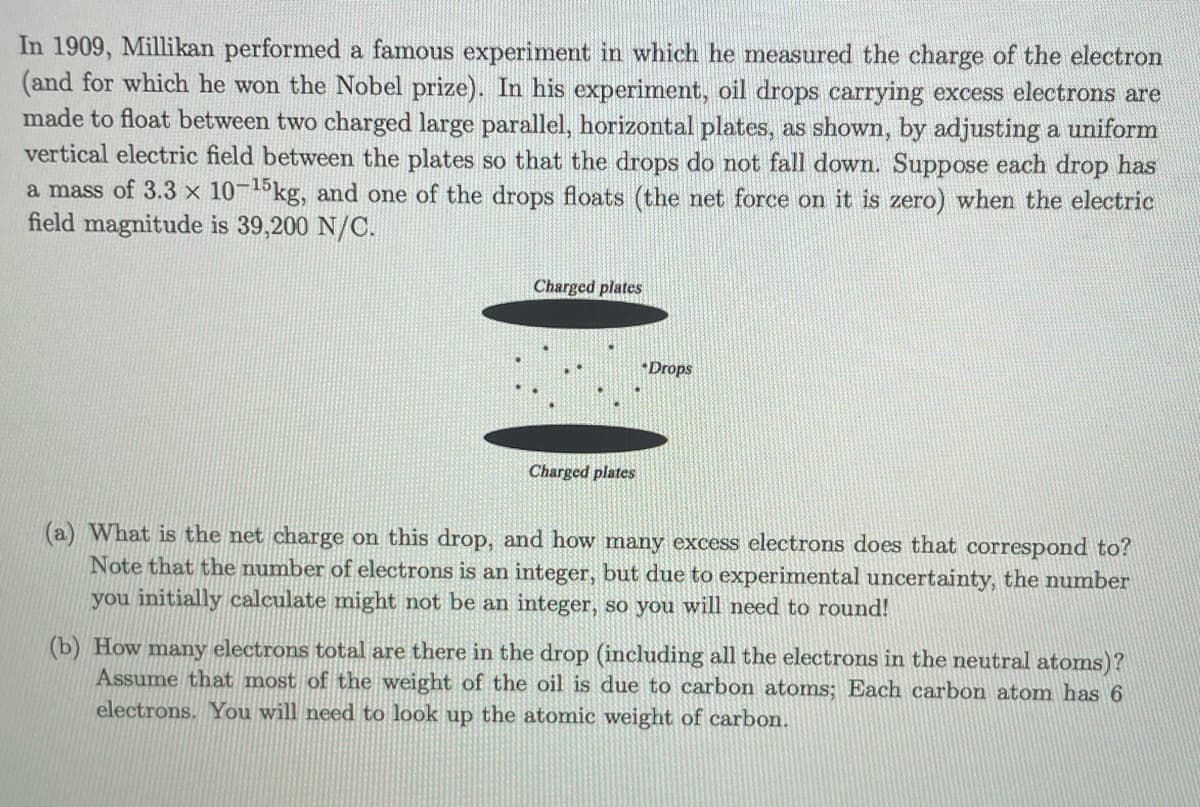In 1909, Millikan performed a famous experiment in which he measured the charge of the electron (and for which he won the Nobel prize). In his experiment, oil drops carrying excess electrons are made to float between two charged large parallel, horizontal plates, as shown, by adjusting a uniform vertical electric field between the plates so that the drops do not fall down. Suppose each drop has a mass of 3.3 x 10-15kg, and one of the drops floats (the net force on it is zero) when the electric field magnitude is 39,200 N/C. Charged plates Charged plates Drops (a) What is the net charge on this drop, and how many excess electrons does that correspond to? Note that the number of electrons is an integer, but due to experimental uncertainty, the number you initially calculate might not be an integer, so you will need to round! (b) How many electrons total are there in the drop (including all the electrons in the neutral atoms)? Assume that most of the weight of the oil is due to carbon atoms; Each carbon atom has 6 electrons. You will need to look up the atomic weight of carbon.
In 1909, Millikan performed a famous experiment in which he measured the charge of the electron (and for which he won the Nobel prize). In his experiment, oil drops carrying excess electrons are made to float between two charged large parallel, horizontal plates, as shown, by adjusting a uniform vertical electric field between the plates so that the drops do not fall down. Suppose each drop has a mass of 3.3 x 10-15kg, and one of the drops floats (the net force on it is zero) when the electric field magnitude is 39,200 N/C. Charged plates Charged plates Drops (a) What is the net charge on this drop, and how many excess electrons does that correspond to? Note that the number of electrons is an integer, but due to experimental uncertainty, the number you initially calculate might not be an integer, so you will need to round! (b) How many electrons total are there in the drop (including all the electrons in the neutral atoms)? Assume that most of the weight of the oil is due to carbon atoms; Each carbon atom has 6 electrons. You will need to look up the atomic weight of carbon.
Principles of Physics: A Calculus-Based Text
5th Edition
ISBN:9781133104261
Author:Raymond A. Serway, John W. Jewett
Publisher:Raymond A. Serway, John W. Jewett
Chapter19: Electric Forces And Electric Fields
Section: Chapter Questions
Problem 6P
Related questions
Question

Transcribed Image Text:In 1909, Millikan performed a famous experiment in which he measured the charge of the electron
(and for which he won the Nobel prize). In his experiment, oil drops carrying excess electrons are
made to float between two charged large parallel, horizontal plates, as shown, by adjusting a uniform
vertical electric field between the plates so that the drops do not fall down. Suppose each drop has
a mass of 3.3 x 10-15kg, and one of the drops floats (the net force on it is zero) when the electric
field magnitude is 39,200 N/C.
Charged plates
Charged plates
Drops
(a) What is the net charge on this drop, and how many excess electrons does that correspond to?
Note that the number of electrons is an integer, but due to experimental uncertainty, the number
you initially calculate might not be an integer, so you will need to round!
(b) How many electrons total are there in the drop (including all the electrons in the neutral atoms)?
Assume that most of the weight of the oil is due to carbon atoms; Each carbon atom has 6
electrons. You will need to look up the atomic weight of carbon.
Expert Solution
This question has been solved!
Explore an expertly crafted, step-by-step solution for a thorough understanding of key concepts.
Step by step
Solved in 3 steps

Knowledge Booster
Learn more about
Need a deep-dive on the concept behind this application? Look no further. Learn more about this topic, physics and related others by exploring similar questions and additional content below.Recommended textbooks for you

Principles of Physics: A Calculus-Based Text
Physics
ISBN:
9781133104261
Author:
Raymond A. Serway, John W. Jewett
Publisher:
Cengage Learning

Physics for Scientists and Engineers, Technology …
Physics
ISBN:
9781305116399
Author:
Raymond A. Serway, John W. Jewett
Publisher:
Cengage Learning

College Physics
Physics
ISBN:
9781285737027
Author:
Raymond A. Serway, Chris Vuille
Publisher:
Cengage Learning

Principles of Physics: A Calculus-Based Text
Physics
ISBN:
9781133104261
Author:
Raymond A. Serway, John W. Jewett
Publisher:
Cengage Learning

Physics for Scientists and Engineers, Technology …
Physics
ISBN:
9781305116399
Author:
Raymond A. Serway, John W. Jewett
Publisher:
Cengage Learning

College Physics
Physics
ISBN:
9781285737027
Author:
Raymond A. Serway, Chris Vuille
Publisher:
Cengage Learning

College Physics
Physics
ISBN:
9781305952300
Author:
Raymond A. Serway, Chris Vuille
Publisher:
Cengage Learning


Physics for Scientists and Engineers: Foundations…
Physics
ISBN:
9781133939146
Author:
Katz, Debora M.
Publisher:
Cengage Learning